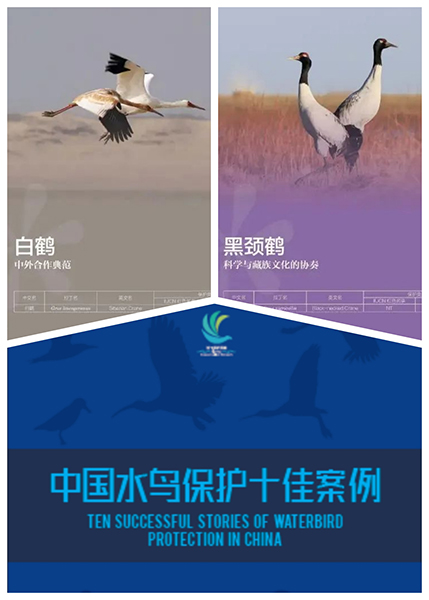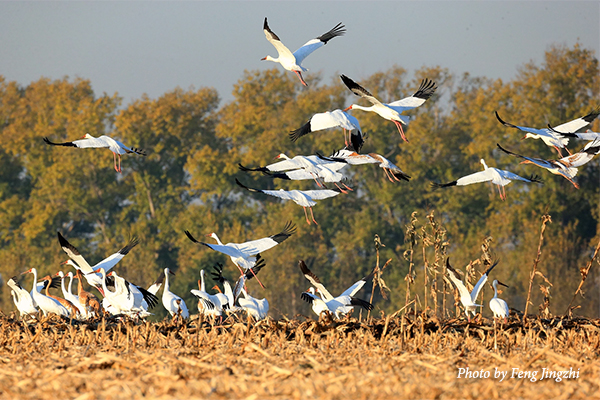Together we must learn, adapt, and improve our wetland conservation and management practices to encourage and sustain people and wildlife. Wetlands can serve as centers of resiliency as we face the global challenges of climate change and biodiversity loss.
Last month, government representatives, conservation organizations and researchers gathered for the 14th Conference of the Contracting Parties to the Ramsar Convention on Wetlands (COP14) in Wuhan, China and Geneva, Switzerland. This was the first time the conference has been held in China.


During the conference, the International Crane Foundation successfully hosted two sub-forums with our partners in China:
- Global Waterbird Flyways and Habits Conservation Forum
- Cross-regional Wetland Action: Connecting People, Species and Habitats
On November 9, we held the Global Waterbird Flyways and Habitats Conservation Forum online. The China Flyway Conservation Network and Ten Successful Stories of Waterbirds Conservation in China were each launched during the forum.

“We know more about migratory pathways and the critical sites individual species need to complete their journeys, especially in stopover areas. These sites are often spread over many countries, meaning we need international cooperation in monitoring and conservation.” Spike Millington, Vice President of the International Crane Foundation, noted in his opening speech.

In the keynote presentation section, Professor Qian Fawen, Director of the National Bird Banding Center, provided an overview of cranes and their conservation in China. During the panel discussion, Yu Qian, Director of the International Crane Foundation’s China Program, shared the foundation’s long history of Siberian Crane conservation as an example of successful cooperation between China and Russia, involving government and non-governmental organizations, nature reserves and local communities, as well as experts and volunteers.

Siberian and Black-necked Cranes were highlighted in Ten Successful Stories of Waterbird Conservation in China, which highlighted not only the great conservation work in China, but also the importance of flyway-level conservation and cooperation among different countries and areas. The Siberian Crane case was written and contributed by the International Crane Foundation’s China Program.
Host organizations launched the China Flyway Conservation Network to:
- Promote the mainstreaming of wetland and waterbird conservation along flyways;
- Develop specifications for wetland and waterbird monitoring along flyways;
- Improve the capacity of habitat management staff along flyways;
- Accelerate exchange and communication to share experiences and increase awareness along flyways;
- Establish bird-friendly communities and industries along the flyways.

The sub-forum, Cross-regional Wetland Action: Connecting People, Species and Habitats, was held on November 12. Focusing on transboundary wetland conservation, representatives from government departments, non-governmental organizations, research institutions, universities, local communities and enterprises were invited to discuss the development of a transboundary wetland conservation network and the connection among people, species and wetlands.

“Cranes have great cultural significance worldwide on five continents and serve as Ambassadors for Wetland Conservation, bringing people together across many nations to secure nature. The International Crane Foundation has established and participated in many conservation networks in Asia, North America and Africa,” said Rich Beilfuss, President of the International Crane Foundation, “with the coordination and cooperation among different stakeholders, some crane species have been well protected.”

Ms. Leafy Li, Senior Manager, Environmental Affairs and Horticulture, Shanghai Disney Resort, introduced the cooperation on Siberian Crane conservation between Disney and the International Crane Foundation in the first panel discussion, including wetland conservation work by Shanghai Disney Resort in China. All enterprise representatives agreed that the private sector plays an irreplaceable role in wetland conservation and concerned stakeholders should work together to improve wetland conservation and waterbird protection.
Together we must learn, adapt, and improve our wetland conservation and management practices to encourage and serve people and wildlife. Wetlands can serve as centers of resiliency as we face the global challenges of climate change and biodiversity loss.
Wetlands are not only the home of cranes, but also the home of people. So let’s work together to save our shared home!



Story submitted by China Program Director Yu Qian and China Program Coordinator Hou Bo. Learn more about our work in East Asia.
